Blue Quandong is a spectacular native flowering tree famed for its gorgeous bark, attractive and fragrant flowers and foliage as well as its brilliantly blue edible fruits.
This large evergreen tree is a prized bush tucker in many parts of the globe where the spherical bright-blue fruits have some nutritious and tasty culinary applications.
Commonly grown in larger gardens as a fruiting ornamental that flowers abundantly from Autumn through Winter and fruits from Spring to Summer, here is everything you need to know to grow and care for this tremendous Australian native in your garden.
More...
Family: | Elaeocarpaceae |
|---|---|
Genus: | Elaeocarpus |
Species: | angustifolius |
Synonyms: | E. grandis, E. ganitrus, E. sphaericus |
Common Names: | Blue Quandong, Blue Marble Tree, Blue Fig |
Location: | Outdoor |
Type: | Tree |
Growth: | 8 to 40 metres tall, 4 to 8 metres wide |
Sun requirements: | Full sun to half shade |
Foliage Colour: | Green |
Flower Colour: | Creamy-white |
Flowering: | Autumn and winter |
Fruit: | Blue edible fruits in spring to summer |
Maintenance level: | Low |
Poisonous for pets: | Toxic to cats and dogs |
Introducing the Blue Quandong Tree

Source: inaturalist.nz
Featuring wavy green leaves that turn red before falling, delicate creamy-white fragrant flowers and decorative shiny blue fruits, you can always rely on this fantastic rainforest tree to be a showy and decorative addition throughout the entire year.
Furthermore, it has an upright and spreading canopy, usually with a straight growth habit, making it the perfect option for a large shade tree for understory plantings.
Now botanically named Elaeocarpus angustifolius, scientific synonyms also include E. grandis, E. ganitrus and E. sphaericus. Other common names include the blue marble tree and the blue fig tree.
Part of the Elaeocarpaceae family, this plant naturally occurs from India to New Caledonia as well as northern Australia where it can be found in the wild rainforest regions of Queensland and New South Wales.
This tree is considered one of Australia’s fastest-growing rainforest species, often reaching 5 to 6 metres in only a few short years.
Elaeocarpus angustifolius Plant Features
Blue quandong grows to 8 to 40 metres tall and 4 to 8 metres wide depending on the growing conditions. In its warm natural environment, it will commonly reach heights of up to 30 metres or more with a spread of up to 8 metres.
However, outside of its natural habitat in cooler regions, you can expect about half this size. This tree is certainly too large for smaller suburban gardens but is a must-have for larger landscapes, acreage blocks and parks.
Due to its extensive buttress root system at the base of the trunk, this tree’s position will need to be carefully considered, especially near structures and drainage systems.
It is best used as an ornamental shade tree in large tropical, subtropical and warm temperate gardens. The fruits and flowers will attract local birds, bees and butterflies.
Find out more about Quandong and its popular varieties here.


Get Your Free Guide:
Master Growing Australian Natives eBook
A Must Have Complete Guide for Every Australian Garden
Get Your Free Guide:
Master Growing Australian Natives eBook
A Must Have Complete Guide for Every Australian Garden
Growing Blue Quandong in Australia
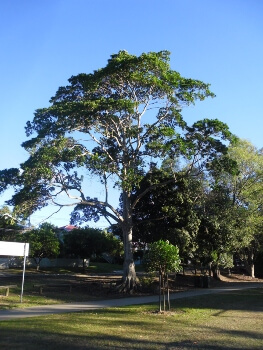
Source: ppnn.org.au
This rainforest tree is best propagated by seeds. The rough, woody stones in the centre of the fruits can be divided into multiple segments, each containing about 5 seeds which you can then use to grow your tree.
When selecting your seeds, try to use only clean, fresh seeds collected from ripened fruits still on the tree as seeds from fallen fruits will most likely be spoiled by fungal spores.
Growing Quandong from Seed
- Prepare a high-quality germination medium like moistened vermiculite or a similar potting soil. Fill well-draining seed trays or small containers and mist lightly before sowing.
- Sow your seeds lightly into the top of the medium, gently pressing them about a centimetre into the soil.
- Incubate the seeds in a dark location like a cupboard indoors with temperatures ranging between 18 to 20°C.
- Examine the seeds weekly and remove any contaminated seeds. Water lightly only if needed.
- Once seedlings start reaching a healthy height after about 2 months, you can then start introducing more light and water to stimulate new growth in the roots. This is also when you should transplant into larger containers.
- Be sure to use big enough containers as the roots are vigorous, often reaching 30cm long in only a few weeks.
- Always try to use a low-phosphate, free-draining potting mix for the seedlings.
- Once seedlings have reached a suitable height, you can transplant them into the ground or a larger container in the garden.
If you are not comfortable establishing large trees from seeds, young and healthy nursery plants are always a great idea as they are easier and quicker to establish meaning you’ll have a flowering and fruiting specimen far sooner.
Ideal Conditions for Planting Blue Quandong
Being a rainforest tree, this plant will naturally thrive and grow best in warm, moist conditions. Though it can also be grown in cooler climates, fruiting and flowering will almost always be affected.
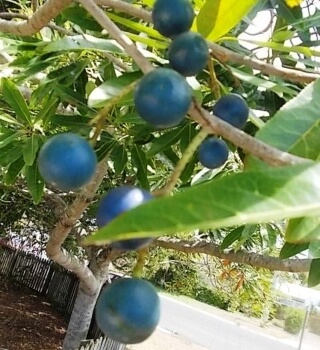
Source: sunblestproducts.com
Here are the optimal growing conditions that you should try aiming for in your garden.
Blue Marble Tree Sunlight Needs
With fruiting trees, it’s always best to aim for sunnier positions rather than shaded spots. This tree can grow in full sun to half shade where blooms and fruits will be more compromised in shadier, cooler locations.
For prolific harvests and flowers, sunny and warm conditions are best.
Best Soil for Blue Fig
Preferred soils are rich soils that retain moisture but drain easily. Though this tree can tolerate sandy soils, it will grow best in loamy, sandy-loam or clay-loam soil types. The soil pH should be neutral to slightly acidic (4.5 to 7.5). Find a soil test kit here.
Garden Temperature & Humidity
The tree will grow best in areas with a daytime temperature range of between 18 to 28°C but it can tolerate temperatures of between 8 to 38°C. The preferred mean annual rainfall should average in the range of about 1,000 to 3,500mm.
General garden humidity should suffice in the right environments but in cooler climates with less rainfall, occasional misting may be necessary. Alternatively, to increase humidity naturally, you can consider planting more vegetation around the tree.
How to Care for Blue Marble Tree
Once established, the tree can tolerate light frost and some drought. Normally, it will do best if sheltered in the winters and watered well in the summers.
Due to the tree’s natural tolerance to our endemic conditions, care is often quite easy and minimal but certainly appreciated in cultivation.
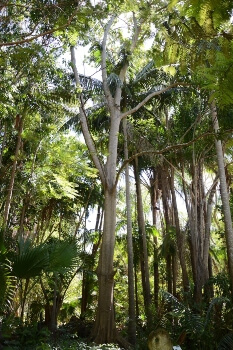
Source: bambooland.com.au
Watering Blue Quandong
This is a tree species from high rainfall areas but it can tolerate up to about 90 days without any rainfall or supplemental watering. Water well in the initial couple of growing years after planting then water as needed once established to maintain healthy soil moisture throughout the year.
This could mean deeply watering every 10 to 30 days depending on your rainfall and heat.
Fertilising Needs
Though not needed, you can feed your tree with a balanced garden fertiliser at the seedling and sapling stages in spring to encourage more growth. You can also feed annually from spring to summer once established with a slow-release native plant fertiliser to increase blooms and fruits.
See our Yates fertiliser buying guide for 2024 here for more information.
How to Prune Blue Quandong
Usually, with rainforest trees, pruning is always a necessity and it’s no different with this species. When young, prune regularly by just cutting back the actively growing tips of foliage from the top and side branches about twice a year to promote a dense and compact growth habit.
Once fully established after about 7 to 10 years when the tree is fruiting and flowering properly, prune in spring to summer as needed to maintain a tidy shape.
Mulching for Optimal Moisture
Because these trees need a warm and moist environment to thrive, mulching, especially when young, is a great way to help your tree retain adequate moisture levels.
Mulch annually to bi-annually in summer by adding a 5 to 7cm layer of organic mulch around the base of the tree.
Find out more about the best types of mulch for your garden as well as when and how to use it.
Blue Quandong Bush Tucker Guide
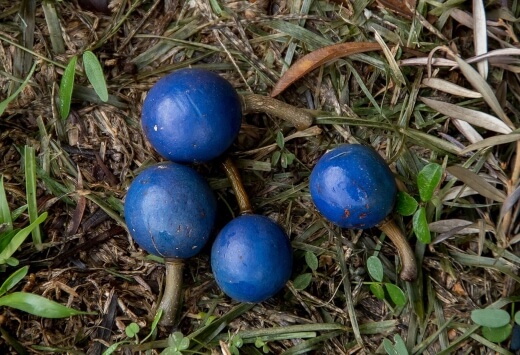
This popular Aboriginal bush food is quite simple to use at home in the kitchen. It is important to remember that this tree will only begin bearing fruits from about year 5 to 10 onwards depending on the growing conditions.
These brilliantly blue-coloured fruits are usually spherical and contain large pits covered by the outer fruit flesh. Each fruit weighs an average of 7 grams but they can range anywhere from 4 to 10 grams and they grow to around 2 to 3cm in diameter.
The brightly coloured blue skin is produced by a microscopic structure similar to the wings of birds and butterflies. The flesh inside is thin and pale green, surrounding a hard seed with a bumpy texture.
How to Use Blue Quandongs
Traditionally, these fruits were famed for their medicinal properties. Fresh fruits were mixed with water to make a paste which was then consumed and this is one way we can still use these fruits today. Even early European settlers used the fruits in jams, jellies and pies.
When it comes to taste, the fruits have a tangy-bitter flavour with meagre flesh, often not palatable enough for most. They taste best when slightly over ripe and soft to the touch.
- Simply harvest ready fruits directly off the branches or collect fruits from around the base of your tree then clean them before use.
- Separate the bright blue skin from the green flesh and use the flesh as you see fit.
- Blue quandong fruits have a vitamin C content higher than oranges and also contain some essential micronutrients and minerals.
- You can mix the ripened fruits with water to use them as a paste which can be eaten fresh or mixed into your favourite dishes.
- You can dry or freeze fresh fruits for use at a later stage. The fruits will shrink if dried but last for up to 8 years frozen without impairing flavour.
Common Blue Quandong Pests & Diseases
Overall, this tree is extremely resistant to pests and disease when cultivated in gardens. When young, few issues can trouble these tough plants. Once matured when your tree is fruiting and flowering, some small issues can become a problem in certain conditions.
Foliage-eating caterpillars and sap-sucking insects like aphids, mites and scale could become a frustration. Luckily, by using an organic insecticide or neem oil, you can most likely get rid of these problems without having to call in professionals.
For an at-home remedy, try mixing some dish soap with some water and then occasionally spraying the foliage to deter these critters.
Lastly, fruit fly infestations are also possible within these fruits. Females will lay their eggs into the fruits by stinging them and this can lead to many life cycles of fruit flies becoming an issue within your landscape.
Luckily, we just published an in-depth guide that covers how to prevent, identify and treat fruit fly infestations in your garden.
Blue Quandong Frequently Asked Questions
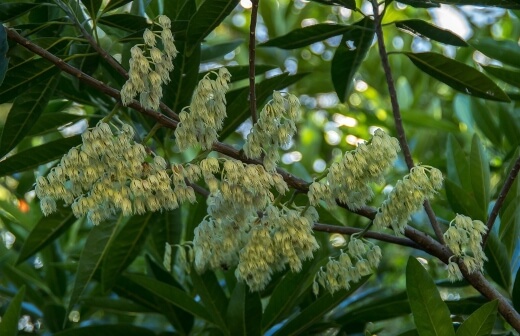
Why is my blue quandong not producing fruit?
This is most likely because your tree is not old enough yet. Even in warm climates, trees can take 7 years to start bearing fruits. Be patient and you should have a fruiting specimen in a few years.
Should I plant another species with my blue quandong?
As this tree is not a parasitic species, it will grow perfectly fine without any nearby host plants or trees.
Can dogs eat quandongs?
No, these fruits are unfortunately mildly toxic to cats and dogs so fallen fruits should be collected readily if you have roaming pets that enjoy munching around the garden.
Interested in learning more about our fantastic bush tuckers? We’ve got an entire section dedicated to our most cherished and nutritious fruiting plants. Get to know more about Australian Bush Tuckers here.
Boost Your Gardens Native Blooms and Fruits with Blue Quandong
This exceptional Australian rainforest tree is a must-have for those who are fans of native flowering and fruiting trees, especially for those who have the space for this large addition.
Ornamental and decorative in every way, this tree can certainly be a stand-out in any garden, regardless of the setting.
Whether used for shade, stature or for its edible fruits, blue quandong is one of our most vigorous rainforest trees that deserves its beloved reputation among garden enthusiasts across the country.
Published on September 19, 2022 by Nathan Schwartz
Last Updated on January 19, 2025




